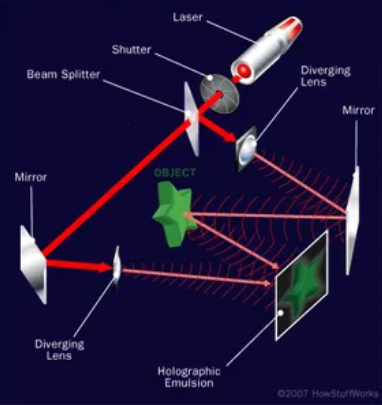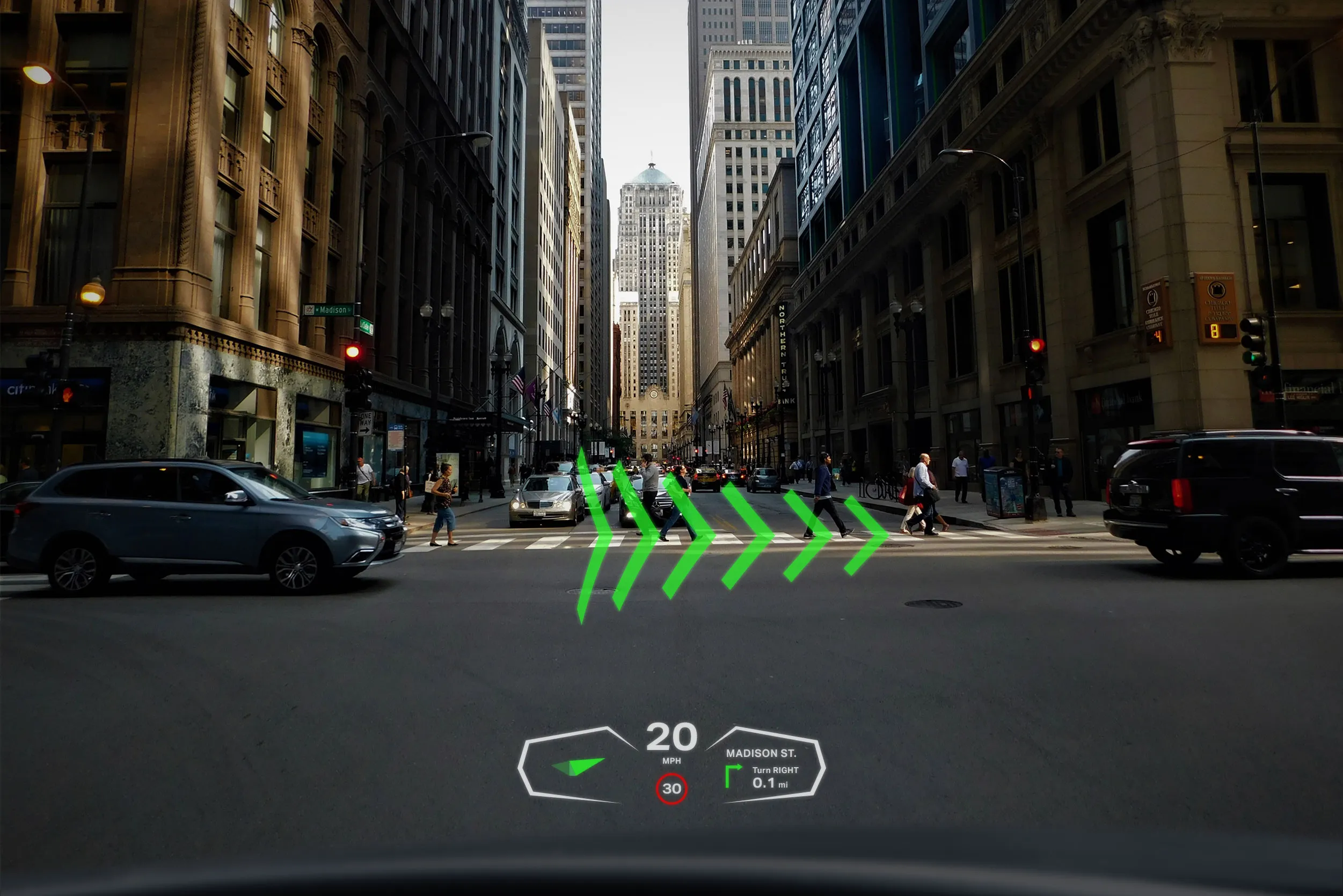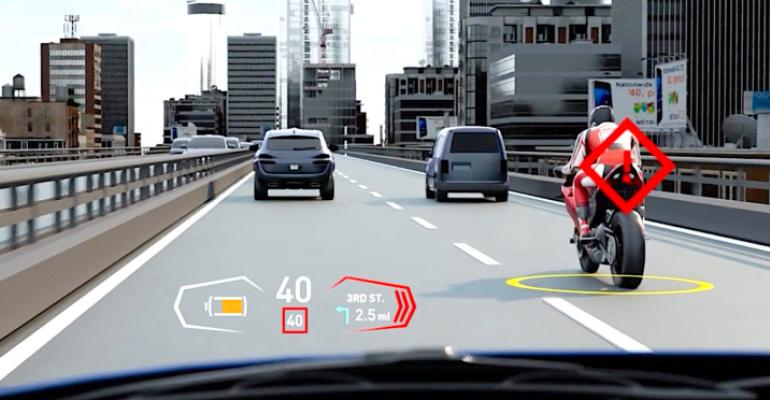With the technological advances being made every day, drivers are exposed to a
never ending increasing amount of visual and audio information whilst operating
a vehicle.
Many countries have enacted laws to limit distractions from mobile phones while
driving.
Despite those laws, the challenge persists, made evident in France where
approximately 14% of accidents in 2020 were attributed to phone usage.
This is where holographic displays make their entrance.
Holographic displays are a new type of technology that can project images into
thin air, making them appear to be three-dimensional.
These displays have the potential to completely revolutionize our current
technology by providing drivers with information in a more immersive and
productive way, in an effort to reduce distractions.
Implementing holographic displays in an automotive environment can create several advantages, as opposed to the conventional two dimensional screens. Improving the driving experience with a more immersive and natural interface has the potential for a simpler and better-quality drive while keeping the driver in control of his car.
This article explores the mechanisms behind holographic display’s functionality, the optimized use of holographic displays in cars and their role in enhancing safety. We will also take a look at the limitations and challenges of the displays as a future car technology, taking a further look at the current competitors in that department.
What is the technology used in the head-up displays?
Before we can explore their application in cars, it is essential to understand the basis of holographic displays. Unlike any two dimensional screen, holographic displays work by creating a three-dimensional image that appears to be floating in space, without the need for any additional eyewear or headset. Achieving this involves deconstructing and reconstructing different light sources to replicate the natural interaction of light with objects.
Diving into the captivating realm of holographic displays unveils a unique mixture of light and precision engineering. The very core of this technological discovery is mostly composed of precise laser work, meticulously combined to create a whole new visual experience.

The process is unfolded in a series of complex steps:
Holographic displays use one or multiple light sources, which are usually lasers, to produce a single wavelength light. This light source is essential to allow proper patterns required for holography.
In most cases, the light created by the laser is split into two beams, called respectively the reference beam and the object beam. The reference beam is directed to a fixed mirror, providing a stable reference point. The object beam is directed towards the object intended for the holographic capture.
As the object beam interacts with the object itself, it scatters off of its surface, essentially capturing details about the object’s structure and particular characteristics.
The scattered light is then intersected with the reference beam onto a photo sensitive material. This intersection creates a pattern of light and dark, effectively recording the 3D information about the object. This recording will be the fundamental element on which the hologram is constructed.
Processing the recording is therefore essential, as to render a coherent and accurate representation of the captured object.
To view the 3D image, a beam of light must illuminate the hologram, interacting with the recorded pattern which reconstructs the 3D image of the object. This is what allows the image to appear to be floating in space.
Upon creation, the holographic image can be viewed from various different angles, in comparison to the conventional flat images offered by regular displays. This extra feature creates a more realistic experience, providing the viewer with different perspectives.
The rendered image of holographic displays is an intricate combination of light work and surface recognition, where technology offers a seamless transition between material and the abstract.
Why would holographic displays be useful in our everyday cars?
Driver’s access to information about navigation through in-car displays and personal devices are more often than not the cause of distraction from the safe management of the vehicle. However, navigation aid is a necessary tool for most everyday drivers, which makes addressing the discrepancy between both even more urgent.
Holographic displays aim to introduce a seamless transition between all visual information inside and outside of the vehicle, enabling a safer driving experience. They can help drivers keep their eyes on the road by projecting important information directly onto the windshield, reducing distractions.
Tackling the navigation issue is holographic displays’ initial goal, aiming to reduce the use of mobile phones or distracting technologies throughout a drive. Though modern cars have built-in GPS systems, reading and understanding them still requires loss of focus from the road. Holographic displays aim to address this by showing information on the windshield, letting drivers always see the road ahead.
Holographic displays can project any relevant GPS information directly in front of the driver, such as direction, distance to next turn, and speed limitations. This can help drivers to navigate more conveniently, creating a smoother transition between road and directions.
In addition, these new displays push the boundaries that GPS’ offer by introducing intuitive and immersive navigation experiences, such as the Envisics head-up display (HUD). This particular HUD offers unique information to its user to make driving easier, such as displaying large arrows to indicate the next turn.

Holographic displays have the potential to revolutionize the way we navigate our cars. By providing drivers with clear and concise information in a way that does not require them to take their eyes off the road, these immersive displays can help to make driving safer and more enjoyable for everyone.
Another key benefit of holographic displays is that they can provide drivers with more information about their surroundings. Many displays under development are currently working on including information about the drivers surroundings, as to help them stay aware and make better decisions.
Holographic displays can, for instance, monitor the drivers blind spots, projecting a warning signal when a vehicle or object is in the dangerous zone. Regular car detectors and sensors often display visual indicators on both the dashboard or on the relevant side mirrors. However, holographic displays aim to create a safer visualisation of the needed information when displaying the warning onto the windshield. This would not only save the driver the effort of looking backwards or around the vehicule to check, but can also help to avoid dangerous lane changes.
Additionally, holographic displays could project alerts about upcoming traffic conditions or dangerous overhead situations that a driver may not have the time to react to, which would similarily become a safer option then reading the information on the dashboard. This can include warnings about passing pedestrians and nearby cyclists, and even signals about the water levels, all in an effort to create a safer driving experience.

The Envisics Head-up Display is a prime example of safety improvement in action. The head-up system can supposedly display clear and bright warnings onto the windshield to warn drivers of pedestrians, vehicles in their blind spots, and other hazards. It can also provide useful information such as the safe distance from the car ahead and the current speed limit.
Holographic displays are still under development, but they have the potential to revolutionize the way we drive. By providing drivers with more information and warnings in a more immersive and convenient way, they can help to make driving safer and more enjoyable for everyone.
What are the limits of holographic displays?
While holographic displays have the potential to revolutionize the way we drive, there are still some challenges and limitations that need to be addressed before they can be widely adopted in cars. Indeed, both the practical and economical aspects of the implementation of these displays need to be addressed and thought through, as to limit any unnecessary problems.
The size and weight
One challenge is that holographic displays are still in their early stages of
development, and can be quite large and heavy.
This could be problematic in a car as space is quite limited.
The Looking Glass 32’’ is a prime example of how regular holographic displays
can be too large, with it being about 74cm in width and being about 15kg in
weight.
The large size of this display would therefore create problems for the placement
in a vehicle.
Nevertheless, various companies and research groups are actively addressing the
challenge by working on size adaptation for holographic displays.
For instance, researchers at the Berkeley university of California have
developed a new type of holographic displays made out of thin and light
material, making them only a few micrometers thick.
Although they remain in the early stages of development, they could potentially
be ideal for holographic displays in cars.
Moreover, the WayRay holographic display says to have the advantage in this department, with according to the Forbes interview,
We have the advantage in technology and the package. Ours is up to 10 times smaller than conventional HUDs.
The meteorological conditions
Furthermore, the vehicle environment can greatly vary due to the weather and
the meteorological conditions, which means that holographic displays need to be
able to adapt.
Indeed, for instance, to produce the wanted 3D image needed, holographic
displays need a core component: a laser.
However, the different temperatures that can reach the inside of a car can
greatly affect the laser’s output power, rendering it less useful than
necessary.
Additionally, changes in sunlight and brightness can largely change the visual
output of holographic images, making them either hard to see with excess
sunlight, or too bright when in darker environments.
There is a large responsibility to be addressed when manufacturing holographic
displays, making certain that every environmental changes will not degrade
their use and create more danger.
Fortunately, holographic displays companies have recognised these issues and
aim to address them, like the WayRay startup that has produced an augmented
reality navigation system for cars which is said to adapt the bright sunlight
for a clear route.
The cost
Another possible issue in the production of holographic displays is the cost.
As the technologies remain under development, there is no way to get an exact
price of the cost.
However, in-car displays are composed of very complex technology, with the need
for a lot of expensive hardware to render a 3D image.
The materials that compose a holographic display can also add onto the final
price tag, especially with the expectations of a high quality car display.
With all of these components added to the manufacturing price, we can expect
holographic displays to remain a premium product in cars for the next few years.
The environmental impact
As we pursue technological advancements, considering the environmental impact of holographic displays is essential.
The manufacturing processes, materials used, and eventual disposal of these
displays should align with sustainability goals.
Research and development of eco-friendly holographic technologies, using
recyclable materials and energy-efficient manufacturing processes, could
mitigate the environmental footprint associated with these displays.
Additionally, efforts should be directed towards understanding the long-term
effects of holographic displays on driving behavior.
While the intention is to enhance safety and convenience, unintended
consequences such as over-reliance on displays or a potential decrease
in the driver’s vigilance must be carefully monitored and addressed.
What existing holographic displays are currently under production?
In the evolving world of automotive technology, holographic displays are set to revolutionize in-car management. While most holographic technologies are still in the development stages, some companies have already started making their mark with offering available options. Noteworthy among these is the HUDway Glass, described as a lightweight phone mount designed to make a smartphone operate as a head up display. Using holographic technology, the display opens up as a plastic lens in front of the user, and displays information such as navigation aid like a typical GPS would. Though this particular device is meant as an add-on to the vehicle as opposed to an integrated technology, the HUDway glass offers a glimpse into the potential that holographic displays may have in the future.
Several companies are investing in the development of sophisticated integrated holographic displays for cars. Amongst those cited previously, companies like WayRay and Envisics are developing next-generation holographic head-up displays that are larger and higher-resolution than anything on the market today.
These companies have raised over $150 million in funding from major automakers like Porsche, General Motors, and Hyundai. Envisics plans to expand globally to meet the rising demand for holographic head-up displays.
DigiLens is another leading innovator in holographic technology. The company is developing a holographic HUD that is specifically designed for cars. It is lightweight, compact, and projects a large, high-resolution image onto the windshield, directly in the driver’s line of sight. This allows drivers to keep their eyes on the road while accessing important information, such as navigation, speed, and safety alerts.
Conclusion
Holographic displays have the potential to revolutionize the automotive industry ,offering a safer, more convenient, and more immersive driving experience. By projecting information directly onto windshields, holographic displays can reduce distractions and enhance navigation, while also improving driver awareness by monitoring blind spots and providing real-time traffic and environmental information.
Companies like Envisics, WayRay, and DigiLens are pioneers in the development of integrated holographic displays for cars, and major automakers are also investing in this promising technology. However, there are still some challenges to be addressed, including the size, adaptability to weather conditions, cost, and environmental impact of holographic displays.
In the near future, we can expect to see holographic displays become increasingly common in cars. As the technology matures and becomes more affordable, holographic displays will transform automotive design and the way we drive.